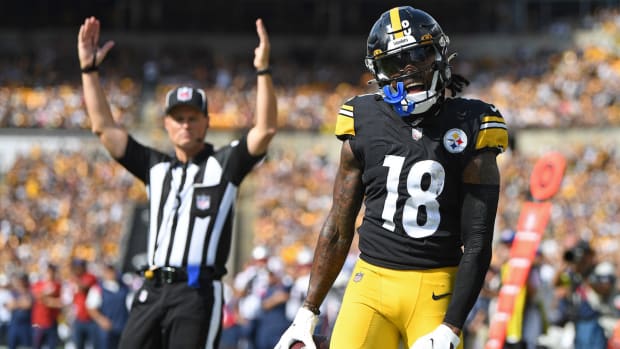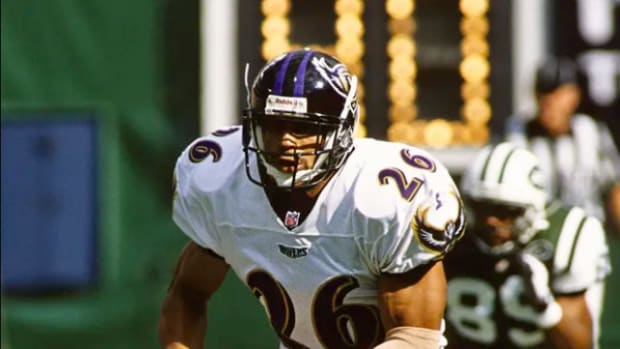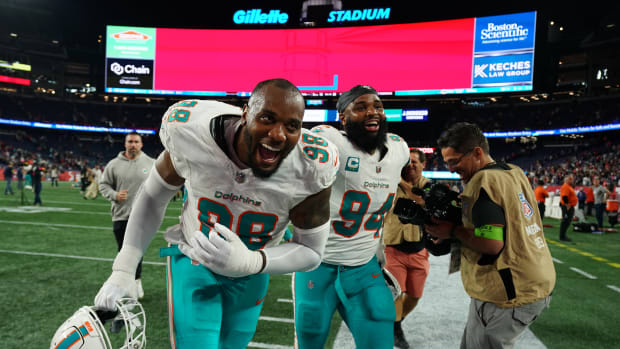How Will Washington Transition to Alex Smith Under Center? 10 Thoughts on 2018 Redskins
With the NFL season just a few weeks away, Andy Benoit is previewing every NFL team in reverse order of last season’s finish. Up today: the Washington Redskins, who finished 7–9 in 2017.
1. Just because Alex Smith was a game-manager in Kansas City and is replacing what amounted to a high-level game manager in Kirk Cousins doesn’t mean Washington made an apples-for-apples QB switch. Cousins is an attack-minded passer who must be reeled in. He throws with timing and rhythm, which—especially on play-action—often translates to anticipation passing, and he’s not afraid to stay firm in the pocket with a big hit looming, as he showed time and again in 2017. Smith, on the other hand, is a dinker-and-dunker who must be prodded into taking chances. He won’t pull the trigger until he sees—and, at times, verifies—a receiver show open. And even in perfectly clean pockets he breaks himself down before working to his backside progressions.
The guess here is Smith will drive head coach Jay Gruden crazy by November. The question is, how much will Gruden tweak his aggressive system to accommodate his QB? Smith ran Kansas City’s misdirection-heavy offense effectively. In Washington, he’ll have some misdirection, but Gruden’s best designs are his intermediate two- and three-receiver route combinations. The good news is many of those stem from bunch and stack releases, which can help clarify a quarterback’s read early in the down. The bad news is they ultimately demand a Kirk Cousins-type approach.
2. We’ll take this opportunity to once again dispel the myth about needing to establish the run to set up play-action. Last season Washington had the NFL’s 30th-ranked ground game (in terms of yards per attempt) but fourth-ranked play-action game. Effective play-action starts with synchronized movement by an offensive line, which is something a Bill Callahan-coached unit always delivers. The ball fakes that define it are crucial as well, but defenders have already started to bite usually by the time they occur. A strong run game could again be hard to achieve with second-round rookie Derrius Guice tearing his ACL in the preseason opener.
3. Callahan’s offensive line features two of the league’s finest on-the-move blockers in left tackle Trent Williams and right guard Brandon Scherff. Williams’s athleticism on the perimeter does wonders for Washington’s screen game. Scherff’s mobility in the trenches defines many of Washington’s man-blocking runs. Both are excellent in Gruden’s foundational zone ground game.
• Andy Benoit’s 2018 NFL Team Previews: Bengals | Dolphins | Raiders | 49ers | More
4. Smith must be willing to throw the ball inside, where Washington’s four top pass-catchers reside. Tight end Jordan Reed is lethal on slants. Slot ace Jamison Crowder sets up defenders for in-cuts and drag routes better than anyone. Tight end Vernon Davis can still hurt defense down the seams. And sensational third-down back Chris Thompson, coming off a November a broken leg that greatly diminished this offense, is most potent on angle routes.
5. In a perfect world, your most threatening receiver resides outside, and if 2016 first-round wideout Josh Doctson is ever to become that guy, it’ll be on the strength of his contested catch ability. Doctson is a lanky 6' 2" and can really climb the ladder when the ball’s in the air. He must hone this attribute because he doesn’t quite have the speed or twitchiness to be highly refined in other areas.
6. Josh Norman is the type of corner who needs a strong pass rush in front of him. His sense for route angles and timing is superb, but when plays get extended, you see the limitations—including his ho-hum speed—that originally dropped Norman to the draft’s fifth round. Norman thrived in Carolina behind the likes of Kawann Short and a youngish Charles Johnson, but his first two years in Washington have, by the lofty standards of his contract, been disappointing.
7. Can Washington’s pass rush help Norman? When you play as much zone as defensive coordinator Greg Manusky, the four-man rush is critical, but Washington’s goes hot and cold. The “hot” is mostly Ryan Kerrigan, who has steadily developed into a master technician, capable of beating tackles with his patented “long-arm” move or by redirecting against them inside. Preston Smith and Ryan Anderson were both recently drafted in the second round to bookend Kerrigan. Smith’s output vacillates but not enough to prevent him from maintaining a significant role. With Anderson, the jury is still out, but what’s really important is establishing a more consistent nickel rush presence inside. Bruce Allen would agree; he’s spent his last two first-round picks on Alabama standouts Jonathan Allen and Da’Ron Payne. They will determine this D-line’s fate.
• THE MMQB AT NFL TRAINING CAMPS: Titans | Chiefs | Bengals | Eagles | Steelers | Colts | Ravens | Lions | More
8. Linebacker Zach Brown’s high-octane 2017 performance earned him a new three-year, $24 million contract ($10 million guaranteed). For this investment to be fruitful, Brown must be more consistent at diagnosing plays. Sometimes he bursts into the picture, other times he looks like he’s counting Mississippis. If Brown sharpens, so will a Washington run defense that ranked 29th in yards per attempt last season.
9. The safety position has been in flux for several years, but that should change with second-year Montae Nicholson in 2018. Playing bigger than his 6' 2", 212-pound size, he sojourns down to the box every now and then, allowing captain D.J. Swearinger to move around just enough for offenses to note.
10. Manusky’s biggest concern is (presumably) his cornerback depth. With Quinton Dunbar opposite Norman, he has a pair of stout perimeter stoppers, but every other spot is a question, starting at the nickel slot, which the team hopes can be manned by second-year pro Fabian Moreau. If it can’t, then (possibly declining) 31-year-old ex-Cowboy Orlando Scandrick will wear the hat.
BOTTOM LINE: Washington has downgraded at quarterback and still has plenty of unknowns on defense. The over/under on the team’s record this season is 6-10.




































